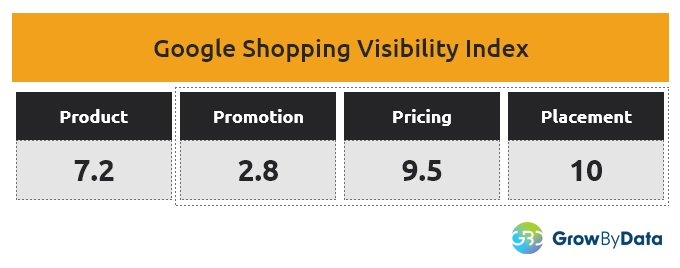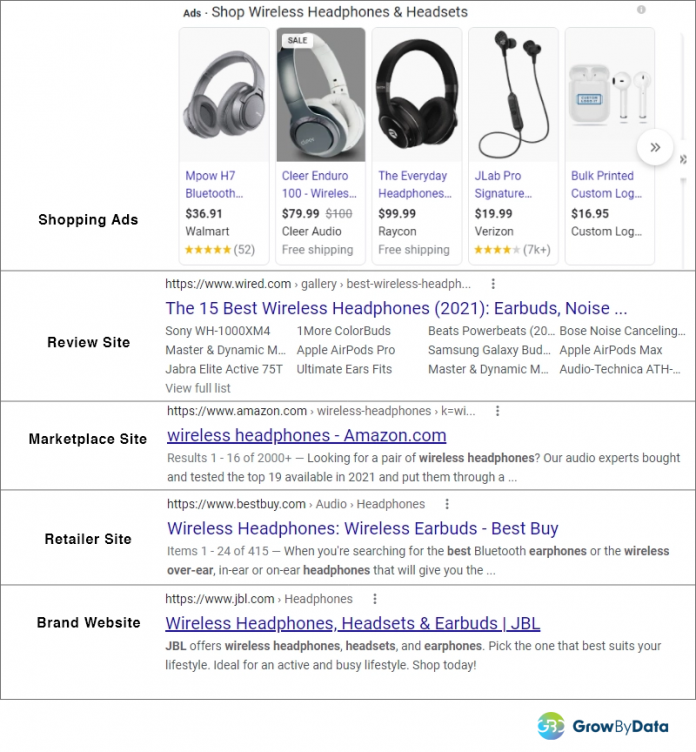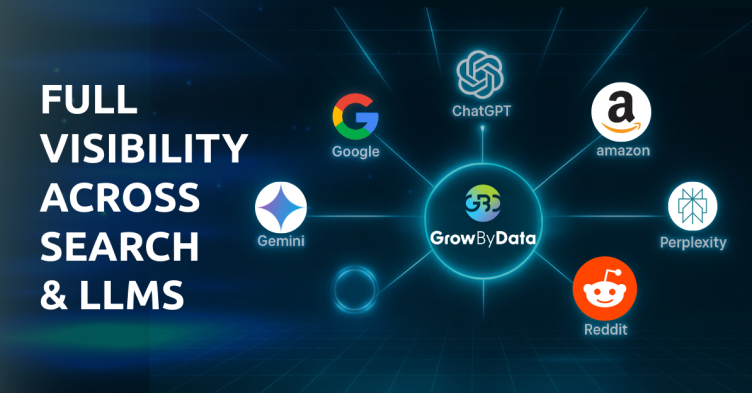In this article, we will explore the concepts of digital shelf optimization and digital shelf analytics as a solution to the problem of collecting, analyzing, and visualizing large amounts of data to optimize a brand or product’s performance on the digital shelf. Before diving into these concepts, let us learn about some of the basics first.
Table of Contents: Show
- What is a Digital Shelf?
- What is Digital Shelf Optimization?
- Why is Digital Shelf Optimization important?
- What are the components of the digital shelf data?
- What is Digital Shelf Analytics?
- How to win the digital shelf?
- What are the benefits of digital shelf monitoring?
- How does digital shelf analytics help in marketing strategy?
- How can Search Intelligence help in Digital Shelf Strategy?
- In Conclusion
What Is a Digital Shelf and Why It Matters in eCommerce?
A Digital shelf is an online version of how and where a particular brand’s products are shown online. Shoppers use the digital shelf to surf, find, compare, and purchase products. It is all the places the digital shopper interacts with your products online. This can be everything from search engine platforms like Google and Bing to marketplaces like Amazon and Walmart, brand websites, social media sites, review sites, category pages, product pages, etc.
What is Digital Shelf Optimization?
Digital Shelf Optimization is the process of continuously optimizing your brand’s presence on the digital shelf to increase visibility. It is the process of increasing your brand visibility by optimizing for both search engines as well as for digital shoppers. Optimizing your digital shelf gives you a better chance to increase your Digital Share of Voice.
The Importance of Digital Shelf Optimization in Winning Search Visibility & Conversions?
Shoppers use the digital shelf to surf, find, compare, and purchase products. It is typically where the digital shopper interacts with your products online, which can be everywhere from search engine platforms such as Google and Bing to online marketplaces like Amazon, Walmart, and Target in addition to brand websites, social media sites, reviews sites, category pages, and product pages.
Digital shelf optimization is extremely important because it determines whether your product can be found or not during a digital shopper’s purchase journey. It provides an opportunity for brands to showcase their products to the shopper during the various stages of the purchase journey to win more sales.
The first page of Google captures almost 90% of search traffic clicks. On Amazon, 45% of the shoppers do not scroll past the 2nd page of the search result. Therefore, it is important to optimize your brand’s presence on the digital shelf, so that you show up on the 1st page, or better yet, above the fold of the 1st page.
Another reason digital shelf strategy is important is due to the evolution in the shoppers’ journey. The traditional purchase journey from interest to research to consideration to decision/purchase is still true, however, it’s a bit messier which Google calls the ‘messy middle’. This concept acknowledges that the shopper’s journey is not linear, and there is so much that happens in between the trigger (need/interest) for a product before the purchase takes place.
What Are the Components of Digital Shelf Data?
The components that should be included in the digital shelf data that will help you win more shares of the digital shelf can be divided into two categories of data.
- The first is the components visible to the shopper like product title, description, images, videos, price, promotions, ratings, reviews, shipping details, and stock availability.
- The second is the components that are behind the scenes for the search engines like Unique Product Identifier (UPI) like GTIN, ASIN, MPN, and product category ensures products are picked for the correct shelf in digital channels.
Collecting and analyzing all these components of the digital shelf helps you understand the areas that need to be optimized. To do this efficiently, you need digital shelf analytics software.
What Is Digital Shelf Analytics and How Does It Work?
Digital Shelf Analytics/Analysis is the process of collecting and analyzing the performance metrics of the product pages throughout the buyer’s purchase journey to improve your brand visibility, click-ability, and buy-ability by enhancing the overall online shopping experience for your customer. The digital shelf performance metrics give you insights so you can understand which areas need improvement and which areas you are performing well allowing you to make the most informed decisions to optimize your digital shelf.
6 Key Elements to Win the Digital Shelf and Outrank Competitors in eCommerce?
Winning the digital shelf means you are providing the best customer experience and catering to the right shoppers at the right moment in their shopping journey. But to win the digital shelf is not easy as the competition is brutal. Everyone is trying to get more reviews & ratings, improve their rankings, and provide more enticing descriptions, images, & promotions to win the sale. Here are a few ideas to win the digital shelf.
- Monitor and continuously optimize your product detail page
- Enhance your images and videos
- Try to get as many customers as you can to review and rate your products
- Fulfill gaps left by the competition
- Understand your customer’s needs
- Make sure you always have stock availability
What are the benefits of digital shelf monitoring?
Manually collecting your competitor’s data on price, product, reviews, promotions, etc. is extremely time-consuming and impractical. To accomplish data collection at a large scale, you need digital shelf monitoring that tracks the entire digital shelf and acquires SERP data for as many keywords from several search engines, locations (local, international, city, region, zip code), and hours of the day. Consistently monitoring the digital shelf allows you to get prescriptive insights to make the right strategic decisions for your marketing campaigns giving you a competitive edge over the competition.
How Digital Shelf Analytics Improves Marketing and Sales Strategy?
Digital Shelf Analytics help understand your performance across the 4Ps of marketing to produce a visibility index. As shown in the table below, the brand is performing well in Google Shopping across placement, pricing, and product, but they are scoring low in the promotion category. Understanding where you fall in relation to your competitors in each metric across the 4Ps allows you to come up with your best marketing strategy.

How Digital Shelf Analytics Powers Smarter eCommerce Marketing Decisions?
As the eCommerce space gets more competitive, occupying the best digital shelf space becomes harder. This means that brands/retailers have to use the best digital shelf monitoring, tracking, and marketing tools such as Search Intelligence software , to stay current, keep up with the fast-evolving trends, and gain the right data shelf insights to make their digital footprint more effective and lucrative. Here are 3 ways how Search Intelligence can help in Digital Shelf Strategy.
- Improve your Digital Share of Voice
- Optimize for the ‘messy middle’
- Improve the buy-ability of your products across the digital shelf e-commerce
- Better understand your competitive landscape
1. Improve Your Digital Share of Voice on all Channels
With the increase of informed digital shoppers and the increase of eCommerce competitors; the complexity of getting your brand’s products in front of the shopper has increased as well. These days, simply having a presence on one platform is not enough, as shoppers are researching products across search engines like Google, Bing, Amazon, etc. before deciding. As a result, brands must try to improve their digital Share of Shelves across all marketplaces and search engines. Search Marketing Intelligence & Marketplace Intelligence helps brands understand what percentage of the digital shelf they are covering for a specific keyword, across all search engines and marketplaces respectively.
We don’t just provide visibility into your position, but also insights on what area you can improve on, in addition to what could be the right content to focus on, to increase your share of voice. It’s imperative to perform a competitive SERP analysis to find out exactly who your competitors are for specific keywords, what kind of results are showing up for specific keywords, what type of content to plan for, and where the greatest opportunities lie.
For example: In the Apparel and Accessories category, the type of questions asked on the ‘People Also Ask’ feature of Google in March 2021 were split as follows:

Understanding what SERP features are popular in 2023 and which features are trending up allows your brand to get ahead of your competitors and skyrocket to the top of the first page. These types of insights help brands like yours (or your clients) decide where they need to increase their prominence to ensure their product/brand is more visible than their competitors.
2. Optimize for the Messy Middle of the Funnel
As mentioned above, the shopper journey is not straightforward. The are many twists and turns afoot while going from a need/want to purchase. An eCommerce statistics study reports, that the average time between a Google product search to buying a product is 20 days, and around 26 days on Amazon. Digital shoppers are doing their due diligence by reading informational sites, and reviews, and looking at multiple platforms, social media sites, brands, and more before deciding. Search Engines are doing their best to write algorithms to best estimate the intent of the searches and provide the digital shopper with the best list of results.
Therefore, it is not enough for a brand to just focus and optimize for a specific SERP feature anymore. Brands need to spread their efforts across the shopper journey. This could mean enlisting on review sites, aggregator sites, content syndication sites, etc. Generating and optimizing for multiple contents that address the informational needs of a shopper at different segments of the journey is almost a necessity to increase market share in the ‘messy middle’.
For example: When we search for ‘wireless headphones’, the search results present as follows:

Therefore, as a brand, digital brand optimization is important to not just try to get your website into the SERP, but it is vital to have contents that are optimized to show up on review sites and other retail sites as well, so that the number of times your brand is seen by the digital shopper increases, thus increasing your brand visibility.
3. Improve Product Buyability and Performance Across the Digital Shelf and eCommerce Platforms
Now that you have done all the hard work and are in front of the shoppers, you may still be losing out on the last part of the shopper journey, which is the purchase, due to your competition having better quality images, better-flowing websites, reviews, etc., which is another aspect of the digital shelf – product attributes.
Product Marketing Intelligence is a digital shelf measurement tool that provides insights to improve the buy-ability of your products. It offers visibility and understanding of the attributes that help your brand’s product stand out from the competition and tempts the shopper to purchase your brand’s product over the rest. It helps you find gaps in content and utilize opportunities to better engage digital shoppers. It’s important to proactively analyze ad extensions by industry and keywords, rather than reactively analyzing and experimenting with winning combinations.
For example, The use of Google Shopping Ad Extensions in the Apparel and Accessories category in March 2021 is shown in the image below.

Another way to improve your buy-ability is by enriching product titles and descriptions with keywords such as brand name, variants (color, material, size), demography (age, gender), model number, manufacturer part number, etc. These features not only increase Ad Impressions but also reduce Max Bid for a better Ad Rank while increasing your Quality Score, for those important keywords that your digital shopper most likely uses in their search queries.
For example, We performed an analysis on one of our clients in the Apparel industry and provided a detailed insight into their product features (price, keyword relevancy, reviews, ratings, promotions, descriptions, etc.) that influence the buy-ability of their products on Google as well as Amazon.

4. Understand Your Competitive Landscape and SERP Visibility
Understanding your competitive landscape is crucial to developing a good digital shelf strategy. Digital Shelf Analytics tools can help you understand your competitor’s ad contents, competitor’s keyword strategies, and overall SERP visibility to get pinpointed opportunities across the SERP components to boost your digital shelf performance.
For example, one of our clients in the apparel industry wanted to understand their competitive landscape in terms of bulk/pack distribution. We found out who their main competitors were for each type of pack (small, medium, and large) as shown on the graph below. This allowed them to categorize and analyze their competitors to build separate marketing strategies for each category.

Digital Shelf Optimization: Boost Visibility, Share of Voice, and Shopper Conversions
Search engines and marketplace platforms are constantly making changes to their SERP presence. With almost real-time visibility on macro and microdata, you can see trends and get ahead of the curve. Search Intelligence is the perfect digital shelf analytics software to help you perfect your digital shelf performance. It provides digital shelf insights into all aspects of the shopper’s journey, ranging from Share of Voice for your brand, enabling a deeper view into shopper attributes, and giving digital shelf insights into buying behaviors across the shelf. Our blend of cutting-edge automation and human intelligence gives you the ability to make the right decisions for your brand to increase your digital share of voice.



